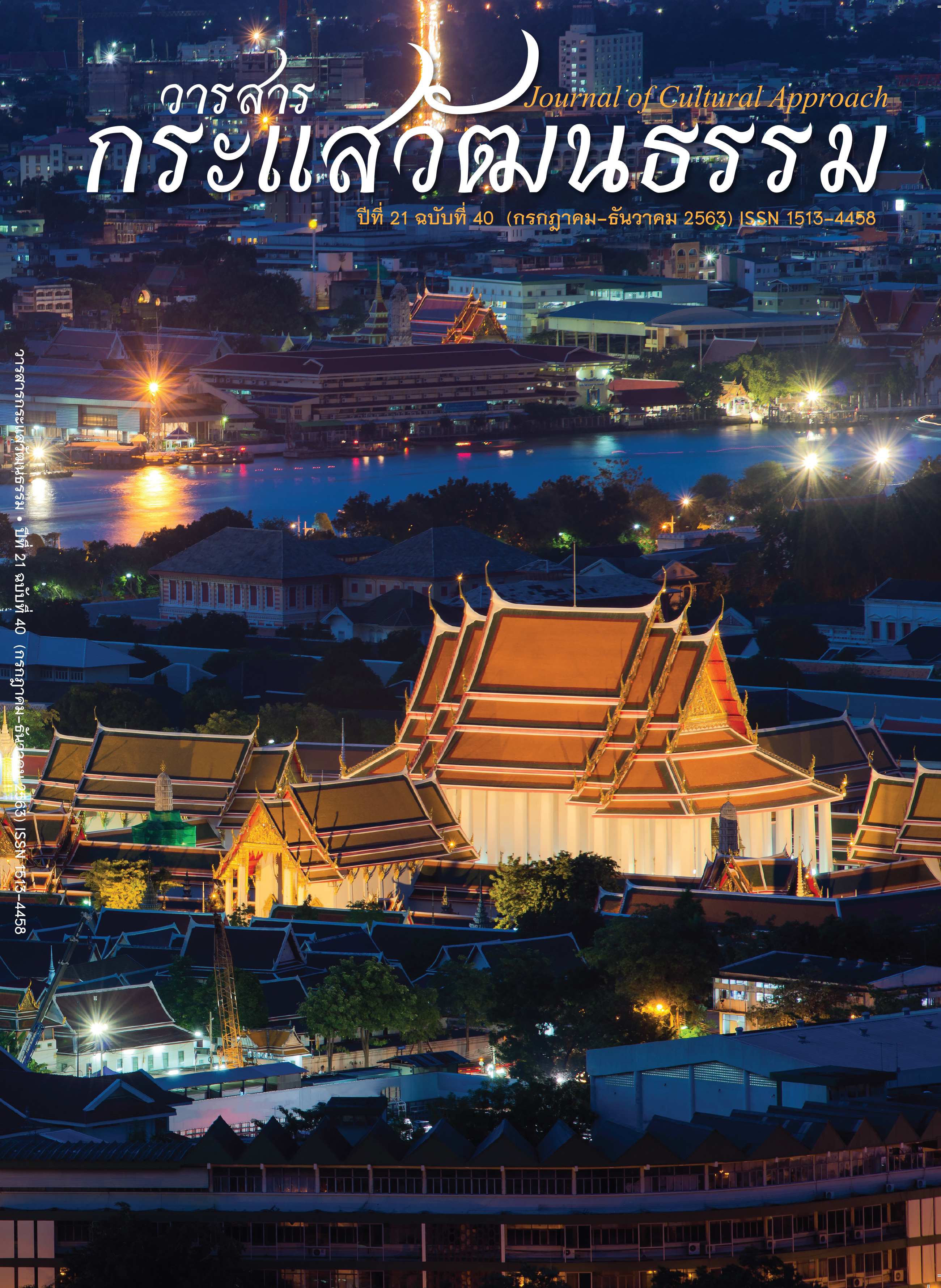Folk Tales in Loei Province Toward Creative Films
Main Article Content
Abstract
This research aimed to develop a creative film from the folklores in Bann Kheangplapok with the collaboration from relevant parties. Research and Development were applied. Qualitative data were collected by in-depth interviews, group dialogues, and discussions with the target groups including the community leaders, senior villagers, entrepreneurs, school directors, and parents form the Bann-Kheangplapok school and relevant parties. The results of the study found that Bann Kheangplapok has 9 folklores in terms of utilization. It is used to telling the story for youth development and community development, creative film development by the production of films called “Phi Mun Uoi Pui” (Mun Uoi Pui ghost). The production process was created from the community engagement of Kheang Pla Pok, nearby villages, and relevant parties.
Article Details
Proposed Creative Commons Copyright Notices
1. Proposed Policy for Journals That Offer Open Access
Authors who publish with this journal agree to the following terms:
- Authors retain copyright and grant the journal right of first publication with the work simultaneously licensed under a Creative Commons Attribution License that allows others to share the work with an acknowledgement of the work's authorship and initial publication in this journal.
- Authors are able to enter into separate, additional contractual arrangements for the non-exclusive distribution of the journal's published version of the work (e.g., post it to an institutional repository or publish it in a book), with an acknowledgement of its initial publication in this journal.
- Authors are permitted and encouraged to post their work online (e.g., in institutional repositories or on their website) prior to and during the submission process, as it can lead to productive exchanges, as well as earlier and greater citation of published work (See The Effect of Open Access).
Proposed Policy for Journals That Offer Delayed Open Access
Authors who publish with this journal agree to the following terms:
- Authors retain copyright and grant the journal right of first publication, with the work [SPECIFY PERIOD OF TIME] after publication simultaneously licensed under a Creative Commons Attribution License that allows others to share the work with an acknowledgement of the work's authorship and initial publication in this journal.
- Authors are able to enter into separate, additional contractual arrangements for the non-exclusive distribution of the journal's published version of the work (e.g., post it to an institutional repository or publish it in a book), with an acknowledgement of its initial publication in this journal.
- Authors are permitted and encouraged to post their work online (e.g., in institutional repositories or on their website) prior to and during the submission process, as it can lead to productive exchanges, as well as earlier and greater citation of published work (See The Effect of Open Access).
References
Boonsong Nakphoo. (2018). The Truth in Countryside and His Frustration. Retrieved from http://themomentum.co/boonsong–nakphoo–interview
Dara Ratchaniwat. (2005). Introduction to Film. Bangkok: Ramkhamhaeng University Press.
Jaruwan Chaonuam. (2002).Lao Folk Tales: Characteristics and Relationship with Society. Bangkok: Chula Press.
Kanjana Kaewthep. (2006). Science of Media and Cultural Studies. Bangkok: Edison Press Products.
Kanoksak Thanee. (2013).Funny Story with Presentation of Cultural Identity in Fairy Tale. Master’s Thesis. Faculty of Education, Mahasarakham University.
Kanyarat Vejchasat. (1978). A Comparative Study of the Various Versions of Srithanonchai in Southeast Asia. Graduate School, Chulalongkorn University.
Kularb Mullikamas. (2000). Native Tales. Institute of Culture and Arts Journal, 1(2), 5–12.
Manus Suksai. (2001). Folk Tales. Ubon Ratchathani: Non-formal Education Center.
Montira Tadaamnuaychai. (2009). Knowledge, Creative Economy and the Potential of Thai Film Industry to Develop into A Creative Economy. Ph.D. Thesis. Faculty of Communication Arts, Chulalongkorn University.
Phakhin Srimultri & Netirat Weeranakin. (2016). Short Film Development Based on Storyline Method for Presenting“The 12 Values Passes Through A Community Lifestyle. Journal of Research and Development, Buriram Rajabhat University, 11(2), 47–56.
Phasuk Mutameta. (1992). Folklore and Quality of Life Development. Bangkok: Odeon Store.
Pramul Pimsan. (2002). Language and Literature E–San. Khon Kaen.
Samlee Raksuthee. (2007). Pa Ya: The Philosophy of E-San People Life. Bangkok: Pattanasuksa.
Tawat Punnotok. (2006). Folk Tales. Bangkok: Aksorn Charoentat.
Usa Choibamroong. (2007). A Study of Local Wisdom in Southern Thailand Literature. Master’s Thesis. Faculty of Arts, Srinakharinwirot University.
Veera Rojpojanarat. (2018). Policy of Cultural Promotion. Bangkok: Ministry of Culture.
Virtue, D. C. & Vogler, K. E. (2008). The Pedagogical Value of Folk Literature as A Cultural Resource for Social Studies Instruction: An Analysis of Folktales from Denmark. Journal of Social Studies Research, 32(1), 28–39.
Walirat Munturaj. (2004). An Analysis of Khmer Folktales of Sri Sa–At Sub–District, Khukhan District, Si Sa Ket Province. Graduate School, Silpakorn University.
Wichian Ketprathum. (1999). Folk Tales for Children and Youth. Bangkok: Pattanasuksa


